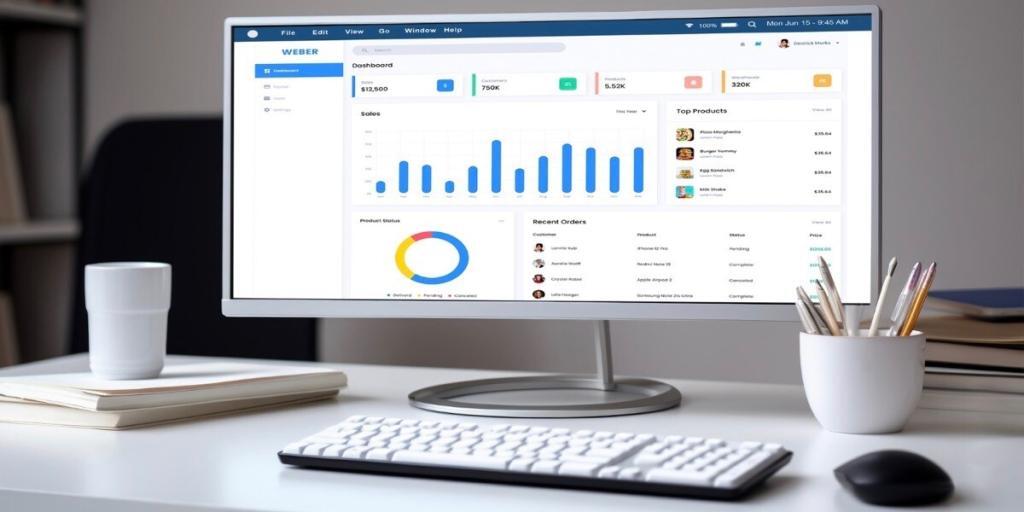
SEO for WordPress: Why Does It Matter and How to Optimize Your Site for High Rankings?
WordPress and similar content management platforms have long revolutionized business digitization. With this platform, small to large businesses have been able to build, customize, and manage their websites effortlessly, with no extra investment in coding or maintenance. Yet, while website creation has become nearly effort-free, this doesn’t cancel the importance of putting additional effort into search engine optimization to make your WP site noticeable on the web.
Why does WordPress SEO optimization matter in today’s market? And how do you make the most out of it? This article will give you a comprehensive guide for outshining the competition in search engine result pages (SERPs).

WordPress and SEO: Why Should You Care?
While WP empowers businesses and solopreneurs to build custom websites and get them active, search engine optimization deals with your visibility on the web. Without SEO optimization for WordPress, you may struggle to get noticed in search engines and attract visitors (traffic) to your site.
There are also other, deeper benefits of WordPress SEO optimization. Namely, it can help you:
- Establish brand recognition and visibility;
- Grow credibility and trust through establishing industry expertise;
- Improve user experience and engagement;
- Attract your target audience and enhance conversions;
- Gain a competitive advantage;
- Ensure high rankings in SERPs.
All in all, search engine optimization ensures your site’s success on the web, which is why it matters for both custom-built and WP sites.
The Role of Third-Party Tools and Plugins in SEO for WordPress
Now that you know the huge importance of WordPress SEO for your competitive advantage and success, you must be wondering how to optimize your site for high rankings. Further in this guide, we’ll share with you some of the most effective WordPress SEO tips, but first, let’s define the role specialized tools and plugins play in this process.
While many SEO tasks can be performed manually, relying solely on human performance can leave you missing out on a bunch of opportunities. Third-party SEO tools and integrated platforms offer a long list of benefits, such as:
- Big data analysis for more informed decisions;
- Real-time suggestions on how to improve your on-page, off-page, and technical SEO;
- Task automation for better productivity and faster results;
- Improved marketing ROI.
To gain these and many other benefits, it’s pivotal that you empower your SEO WordPress website with a set of tools and plugins, such as:
- Keyword research tools;
- On page SEO checker tools;
- Off-page SEO tools;
- Technical tools (such as those for site speed optimization);
- Analytics tools.
Once you have everything you need to start your WordPress SEO optimization, carry on with the help of practical tips we’ll give you further.
WordPress SEO Tips: 9 Ways to Optimize Your Site for High Rankings
As you already know, optimization is a crucial part of ensuring your site’s success. Now, let us give you some of the most efficient tips on how to improve SEO on WordPress step by step:
1. Pick an SEO-Friendly Theme
Effective SEO for WordPress begins with choosing the right theme that would enable you to optimize your site for maximum success. A good theme should meet the following criteria:
- Have a clean and quality code;
- Have a responsive layout;
- Work on multiple browsers;
- Demonstrate good technical performance;
- Support the plugins you might need;
- Offer timely support and regular updates.
Using these criteria, you should be able to select a theme that will give you a good starting point for your optimization. If you need extra advice to get on the right track, some well-known SEO-friendly WP themes include SEO WP Theme, Astra, OceanWP, and Divi. Make a choice based on your business vision and needs.
2. Pick and Install the Key Plugins
As you already know, SEO tools play a pivotal role in creating and implementing an effective strategy. Thus, after selecting a suitable theme, you need to pick and install the key plugins you’ll need to streamline your workflow.
Luckily, WordPress has a large library of over 1,000 SEO plugins. There are all-in-one tools that combine multiple optimization functionalities, as well as narrow-focused tools. In order to select the right plugins, carefully assess your needs and goals. Then, explore the WP library, comparing the functionality, ratings, and reviews of different tools and select the best ones using the criteria we shared with you earlier.
3. Optimize Your SEO WordPress Website Structure
Although site structure isn’t a direct ranking factor, it matters for your rankings for several reasons. Firstly, a well-optimized structure helps search engine bots understand your site better and, thus, find and index your content more efficiently. Besides, the convenient structure also determines user experience. If your site is user-friendly, it enhances the likelihood of visitors staying on it for a longer time, thus improving your bounce rate and time on the page, which also matter for rankings.
So, how do you optimize your SEO WordPress website for better structure? Here are a few practical tips:
- Create a clear page hierarchy. The perfect structure should look like this:
- Homepage
- Categories/sections
- Subcategories (use this if your site is big)
- Individual pages and posts
- Prioritize user experience and convenience. Use menus, search features, internal links, etc., to create smooth and simple navigation.
- Group your content by topics with the help of tags.
4. Handle On-Page Optimization
On-page optimization is a crucial part of WordPress SEO. Here’s how to handle it step by step:
- Use keyword research tools to determine high-potential queries that will help users find your content on the web. Select keywords based on relevance, search volume, and competition.
- Optimize your existing content with target keywords. Integrate queries into content body, headings, and subheadings for maximum outcomes. However, always ensure that keywords look organically in your content and avoid stuffing.
- Create and optimize title tags and meta descriptions for your pages. Keep them brief (55-60 characters for titles and 150-165 characters for descriptions), relevant, and descriptive while also generating interest to gain more clicks.
- Integrate images into your pages for better engagement and readability. Optimize images with descriptive file names and alt texts, integrating your primary keywords into them where possible.
- Use internal links for better navigation and time on the page. Don’t hesitate to integrate keywords into anchor text where possible.
- Create user-friendly URLs and optimize them with your target keywords. Ideally, URLs should be intuitive and easy to remember, such as “Domain.com/category/postname.”
5. Test and Optimize Site Loading Speed
Page speed is known to significantly affect user experience, which is why it’s among the things considered when identifying your rankings. Google’s Core Web Vitals is a set of three metrics that determine the page’s real-world loading performance, interactivity, and visual stability. Meeting these metrics eventually helps you secure the best user experience and gain higher positions in SERPs. That’s why testing and optimizing loading speed is an important part of improving SEO on WordPress.
For starters, test how quickly your site loads using specialized tools like Google Pagespeed Insights. If your results don’t match the general benchmark of loading in 2.5 seconds or less, here’s what you can do:
- Implement content delivery network (CDN).
- Reduce the number of redirects and JavaScript and CSS files.
- Assess your images and resize them if they are hindering your speed.
- Install browser caching plugin.
- Get rid of plugins you’re not using.
6. Make Your Site Mobile-Friendly
Apart from loading performance, mobile-friendliness is another direct factor influencing your success. Today, Google uses solely a mobile version of your site to index and rank sites, meaning that if your site isn’t mobile-friendly, it can’t appear in search results.
The good news is that WP makes implementing a responsive, mobile-friendly site easy. As long as you pick a friendly theme, your pages should look good on all devices. You can check this by previewing the mobile version of the site in the WordPress editor. Additionally, use these extra tips for success:
- Instead of using images with text (which can get cut and look bad on mobile), add text over images in the editor. This way, your text will be responsive.
- Use em or rem units instead of pixels (px) when setting your font size for responsiveness.
- Pick an overlay menu instead of a text menu.
- Use a “stack on mobile” feature to enable WP to use space on mobile screens best.
- Use the “Allow to wrap to multiple lines” option to improve readability on smaller screens.
7. Implement Technical SEO for WordPress
Technical SEO deals with the technical performance of your site, which determines user experience. You already have a few technical tips on how to improve speed and mobile-friendliness. Here are a few bonus tips for optimal performance of your SEO WordPress website:
- Use specialized plugins to detect and fix broken links and redirects.
- Get rid of duplicate content.
- Create an XML sitemap with the help of plugins and submit it.
- Use robots.txt files to avoid clocking crucial pages from crawling.
- Use plugins like Schema Pro to add schema markup to your pages.
8. Establish Security
Security breaches greatly hinder user experience and can eventually harm your brand reputation in the long run. Besides, security is one of Google’s most important goals, meaning it also affects rankings.
Here are some simple things you can implement with WP to secure your site:
- Implement an SSL certificate that is available as a part of WordPress website hosting services.
- Choose plugins that have regular updates and keep them updated.
- Install a solid security plugin.
- Establish and maintain a clear cybersecurity policy.
- Keep an eye on any emerging cybersecurity issues to be able to react swiftly.
9. Build Quality Backlinks
If you want to implement the best SEO for WordPress, off-page optimization should be among your top priorities. Building backlinks as part of your off-page efforts helps you establish authority and expand your outreach, leading to better rankings and traffic.
Use the following techniques to drive quality backlinks:
- Create high-value content that others would want to refer to.
- Engage in guest blogging on relevant and trusted sites.
- Use broken link-building.
- Try a skyscraper technique.

Conclusion
As you now know, WordPress and SEO are closely bound. While WP lets you create your website and get it out there, SEO helps build authority and drive the traffic you need to grow your business.
After reading this article, you have a complete WordPress SEO guide that should help you outshine your competitors in SERPs. One final tip we’d like to give you is to continuously measure your results using analytics and adjust your strategy according to your goals.
